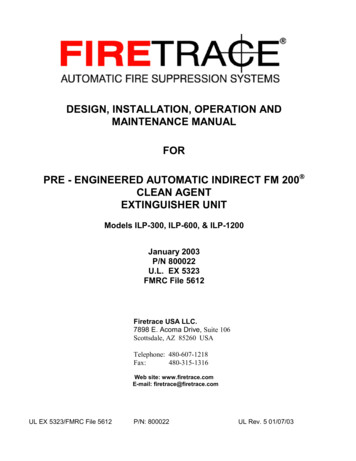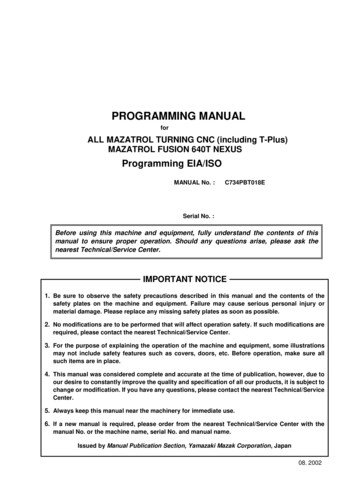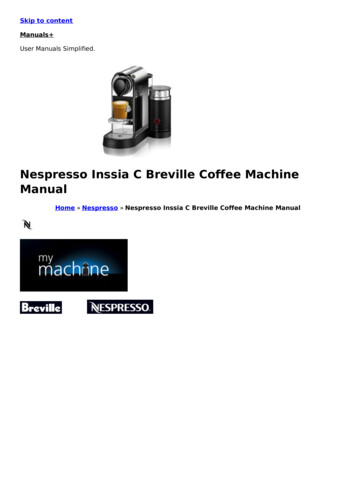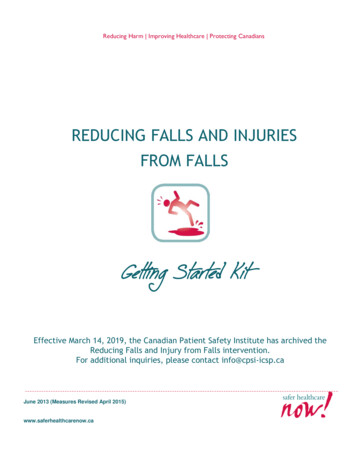
Transcription
The Basics ofStandard Precautions1
PresenterKaren Jones, RN, MPH, CICInfection PreventionistSt. John Hospital and Medical CenterContributions byLinda R. Greene, RN, MPS, CICUniversity of Rochester Medical CenterHighland HospitalLona Mody, MD, MScUniversity of MichiganAnn Arbor VA Health System2
Learning ObjectivesIdentify the key principles of Standard Precaution in health careenvironmentsDescribe appropriate and effective personal protectiveequipment (PPE) use3
Preventing Transmission with Standard PrecautionsInfection prevention practices used to avoid thetransmission of infectious agentsOne of the most important strategies to preventtransmission of infectious agentsFirst line of defense to break the chain of infectionEffectiveness of Standard Precautions depends on how wellsteps are followed(Siegel JD, CDC Guidelines for Isolation Precaution, 2007 )4
Standard PrecautionsUsed with any patient, regardless of their known orsuspected infection statusAssumes any patient’s blood or body fluid may be infectiousConsider what type of infection control practices should beused based on the level of anticipated contact with thepatient(Siegel JD, CDC Guidelines for Isolation Precaution, 2007)5
Key Points AboutPersonal Protective Equipment UseSelection of PPE is based on the nature of the patientinteraction and potential for exposure to infectious materialPut on (don) PPE prior to coming into contact with thepatientBe aware of self-contamination when PPE is usedPerform hand hygiene after PPE removal(Siegel JD, CDC Guidelines for Isolation Precaution, 2007 )6
Glove Use in Standard PrecautionsWear gloves when anticipating contact with apatient’s: Blood or body substances (i.e., fluids or solids) Mucous membranes (e.g., nasal, oral, genital area) Non-intact skin (e.g., wound or surgical incision) Insertion point of a patient’s invasive or indwellingdevice(Siegel JD, CDC Guidelines for Isolation Precaution, 2007 )7
Donning GlovesSelect correct type of glove and sizeExtend to cover wrist, over isolation gown if wornSequence of PPE donning, gloves are often the lastitem to be put on(CDC, Sequence for Personal Protective Equipment, 8
Doffing GlovesThere are a variety of ways to safely remove gloves, one option is:– With the gloved hand, grasp the palm area of the other glovedhand and peel off– Hold removed glove in gloved hand; slide fingers of unglovedhand under remaining glove at wrist, peel off and discardSequence of PPE doffing, gloves are usually the first item to beremoved(CDC, Sequence for Personal Protective Equipment, 9
Gown Use in Standard PrecautionsWear when contact between clothing or skin with patientblood or body substances is expected.For example: Contact with patient’s non-intact skin (e.g., wounds) During procedures likely to generate a splash or spray ofblood or body fluid Handling containers or patient fluids likely to leak, splashor spill(CDC, Sequence for Personal Protective Equipment, 10
Donning GownsGowns should cover the torso, the legs to the knees, thearms to end of wrist and wrap around the backSlide gowns on with the opening at the back, fasten aroundthe back of the neck and the waist(CDC, Sequence for Personal Protective Equipment, 11
Doffing GownsUnfasten gownPull away from neck and shoulders, touching inside of gownonlyTurn gown inside outFold or roll into a bundle and discardRemove gown and perform hand hygiene before leaving thepatient’s environment (e.g., exam room)Do not wear the same gown between patients(CDC, Sequence for Personal Protective Equipment, 12
Face Mask and Eye Protection Use inStandard PrecautionsWear when anticipating potential splashes or sprays ofblood/body substances during patient careFace Masks–protect nose and mouthGoggles–protect eyesFace shields–protect face (i.e., nose, mouth and eyes)Personal eyeglasses and contact lenses are notconsidered adequate eye protection(CDC, Sequence for Personal Protective Equipment, 13
Donning a Face Mask or RespiratorSecure ties or elastic bands at middle of head and neckFlexible band should fit to bridge of noseFace mask should fit snug to face and below chinFit-check respirator(CDC, Sequence for Personal Protective Equipment, 14
Doffing a Face Mask or RespiratorGrasp bottom ties or elastics of the face mask/respirator,then the ones at the top, and remove without touching thefrontDiscard in waste container(CDC, Sequence for Personal Protective Equipment, 15
Donning and Doffing Goggles andFace ShieldDon:Doff: Place over face and eyesand adjust to fit Remove from the back bylifting the head band overthe ear piece Place in designated area forreprocessing or disposal(CDC, Sequence for Personal Protective Equipment, 16
Key Points of PPE RemovalThe key for PPE removal is to limit opportunities for environmentand self-contaminationOutside front of the PPE is the area most likely to becontaminatedPerform hand hygiene after PPE removalAn example sequence of doffing PPE is as follows:ooooGlovesFace shield/gogglesGownFace Mask(CDC, Sequence for Personal Protective Equipment, 17
Scenario 1You are working in your hospital’s emergency department andyou enter a room to assess a patient who has fallen from abicycle. You see that the patient has a 2-inch arm laceration thatis oozing blood. Before cleaning the wound, what PPE should youdon? Gloves18
Scenario 2You are working in your hospital’s emergency department and you enter thetrauma room to assist with the irrigation of a large, actively bleeding thighwound of a patient who has been in a motor vehicle accident. What PPE wouldyou anticipate using?1.What PPE would you anticipate using? Gloves, gown, mask/goggles or face shield2.What’s the sequence for donning these items? Gown Face Mask/Goggles or face shield Gloves3.What’s the sequence for doffing? Gloves Face Mask/Goggles or face shield Gown4. What might happen?19
Standard Precautions –Key PointsStandard Precautions are infection prevention practicesused to avoid the transmission of infectious agentsStandard Precautions are used with any patient, regardlessof known or suspected infection statusPPE is selected based on the nature of patient interactionand anticipated exposure to blood or bodily fluidsEffectiveness of Standard Precautions depends on how welleach step is followed20
ReferencesRespiratory Hygiene/Cough Etiquette in Healthcare Settings. Centers for Disease Control andPrevention. Available at trol/resphygiene.htmSequencing for Personal Protective Equipment (PPE). Centers for Disease Control and Prevention;CS250672-E. Available at egel JD, Rhinehart E, Jackson M, et al. 2007 Guideline for Isolation Precautions: PreventingTransmission of Infectious Agents in Healthcare Settings. Centers for Disease Control andPrevention. Available at 007.pdf21
Speaker Notes22
Speaker Notes: Slide 1Welcome to this module titled “The Basics of StandardPrecautions.” We will review the critical role of StandardPrecautions as a foundation for preventing healthcare-associatedinfections (HAIs).23
Speaker Notes: Slide 2This module was developed by national infection preventionexperts devoted to improving patient safety and infectionprevention efforts.24
Speaker Notes: Slide 3This module will identify key principles of Standard Precautionsin healthcare environments and describe appropriate andeffective personal protective equipment, or PPE, use.Understanding these two core objectives will set the groundworkto improve the culture of safety related to infection preventionin your health care organization.25
Speaker Notes: Slide 4It’s not uncommon to see patients with infections in healthcaresettings. Standard Precautions are infection prevention practicesused to avoid the transmission of infectious agents, or harmfulmicrobes by Healthcare Personnel and others. StandardPrecautions are one of the most important strategies to preventdisease transmission. So, how well do Standard Precautions workto prevent the transmission of disease? Well, that will greatlydepend on the healthcare worker’s adherence to the stepsinvolved in Standard Precautions.26
Speaker Notes: Slide 5Standard Precautions assumes that all patients have potentiallyinfectious blood and body fluids. In addition, StandardPrecautions adds the focus on preventing Healthcare personnelfrom acting as vectors for Health care associated infections (HAI)pathogens. Healthcare personnel choose PPE based on thenature and type of anticipated contact with each patient.Healthcare personnel do this several times a day without givingit much thought. An experienced healthcare worker will be ableto quickly determine what PPE is needed, gathering thatequipment before coming into contact with the patient orperforming a task.27
Speaker Notes: Slide 5 ContinuedAn example would be wearing gloves prior to performing a blooddraw. The likelihood of coming into contact with patient bloodwould be high during venipuncture and gloves offer an enhancedlevel of protection for individuals performing that task.Afterwards hand hygiene prevents the healthcare provider fromspreading pathogens to the environment or their next patient.This module focuses on proper PPE selection and use in StandardPrecautions.28
Speaker Notes: Slide 6Selection of appropriate PPE is based on what type of interactionis planned or expected. As a reminder, infectious material caninclude secretions and excretions, and may be solid or liquid. Theputting on or “donning” of PPE should be done before cominginto contact with the patient or situation. If PPE becomescontaminated during the course of patient care, healthcarepersonnel must be cautious not to contaminate themselves ortheir surroundings. Removal and replacement of PPE may beneeded if it is grossly contaminated during patient care.29
Speaker Notes: Slide 6 ContinuedAnd remember PPE, specifically glove use, is not a substitute forproper hand hygiene. While PPE use is extremely effective atdisrupting the chain of infection, it does not guarantee 100percent protection from contamination. There is a chance ofinadvertent self-contamination during the removal of PPE. Thatis why appropriate hand hygiene should be performedimmediately following PPE removal.30
Speaker Notes: Slide 7Gloves are the most commonly worn piece of PPE. Examples ofwhen gloves must be worn are shown on this slide. Besidesblood and body fluids, mucous membranes, non-intact skin andthe insertion area of a patient’s invasive device should only betouched with gloved hands. Gloves should also be worn if thepatient’s surroundings or environment are contaminated.Different types of gloves may be available and should be chosenbased on the planned activity. For Standard Precautions we arediscussing non sterile examination gloves. Other activities, suchas environmental cleaning might require different types of gloves(e.g., heavy cleaning gloves).31
Speaker Notes: Slide 8For most encounters requiring glove use, a single pair of nonsterile gloves made of vinyl, nitrile or latex are worn. It’simportant to select the size that best fits the healthcare worker–not too tight to be uncomfortable and possibly tear, and not tooloose that they reduce dexterity and potentially increaseexposure risk. If gloves are worn with a PPE gown, the glovesshould extend over the gown cuffs. Although they are the firstitem of PPE discussed here, they are the often the last piece ofPPE to be donned if other PPE are worn.32
Speaker Notes: Slide 9Removing, or doffing gloves must be done carefully to preventcontamination of the hands. There are a variety of ways to safelyremove gloves and other PPE. One option is for the healthcareworker to grasp the palm area of one gloved hand with the othergloved hand and peel it off carefully. The other glove will be heldin the remaining gloved hand. The ungloved-hand finger will beslid under the remaining glove at the point of the wrist, and thenpeel off the glove. The gloves can then be rolled together anddiscarded into a waste container. Gloves will usually be the firstitem to be removed.33
Speaker Notes: Slide 10Gowns should be used if there is a risk of contamination tohealthcare worker clothing or skin. For the purpose of StandardPrecautions, non-sterile gowns are used. Examples of when agown would be appropriate to don would be a procedure duringwhich clothing may come into contact with a patients non-intactskin, during procedures when splashes or sprays could occur, orwhen handling containers of patient fluids when leaking orspilling could happen, such as disposing of the contents in abedpan.34
Speaker Notes: Slide 11Gowns should cover the torso and be secured behind the bodyallowing free movement with sleeves that fit snugly at the wrist.The material of the gown should be selected based on whetherfluid penetration is likely; if there is a chance of this happening, afluid-resistant gown should be chosen. Gowns should be securedat the back of the neck and waist. If the gown isn’t large enoughto provide coverage, it’s recommended to wear the first gownwith opening in the front and second gown over the first, withthe opening toward the back.35
Speaker Notes: Slide 12Gowns should be carefully unfastened and removed withouttouching the outer surface, slowly pulling away from the face.Remember to always remove and discard a gown before leavingthe patient’s environment, which is usually near the point of exit.A gown should not be worn in hallways or corridors, or betweenpatients, as pathogens can be transferred on the gown from onepatient to another. When doffing the gown after use, rememberthat gloves are typically removed first. However, as analternative you can doff gloves and gown together.36
Speaker Notes: Slide 13Next we will discuss the use of mask and eye protection inStandard Precautions. Face and eye protection will help toprevent splashes or sprays from reaching susceptible mucousmembranes of the face. Face masks, goggles, and face shields(with or without a combined face mask) offer different levels ofprotection to the healthcare worker’s nose, mouth and eyes. Thedecision to use a face mask to protect the nose and mouth withgoggles to protect the eyes; or a face shield to protect the wholeface should be based on the expected exposure. For example, afull face shield without a mask might not be sufficient ifsplashing from below is likely (e.g., when emptying a bucket ofwaste water).37
Speaker Notes: Slide 14Face masks may have ties or elastic bands. Ties should besecured at the middle of the back of the head and the neck.Elastic bands should be separated and stretched around thehead to cover the nose, mouth and chin. It’s important that theflexible band is pressed to form over the nose. This will allow fora better fit by preventing gaps in the mask. The mask should fitsnug to the face and below the chin. A particulate respirator,such as an N95 used during Airborne Isolation Precautions alsofunctions as a barrier to splashes to the nose and mouth.38
Speaker Notes: Slide 15Remove the face mask by grasping the ties or elastic bands andlifting the face mask away from the face. The bottom tie orelastic bands should be lifted over the head first, followed by thetop elastic. It’s then discarded into a waste container. Afterhandling the used face mask, perform Hand Hygiene.39
Speaker Notes: Slide 16Goggles provide protection to the eyes; a face shield will offerprotection to the entire face. These should be secured with theattached ear pieces or headband. It’s important that they fitcomfortably to avoid touching or readjustment during patientcare. To remove goggles or a face shield, the ear or foreheadpieces should be lifted away from the face and placed into adesignated area for reprocessing or disposal.40
Speaker Notes: Slide 17The sequence for doffing PPE is meant to limit the chances forself-contamination.It’s very important to realize which areas of PPE are at greatestrisk to become contaminated. What is most likely to becomecontaminated during PPE use? Besides gloves, the outside frontand sleeves of the isolation gown and the outside front of thegoggles, face mask and face shield at most risk of being exposed.After PPE removal, hand hygiene must be performed with soapand water or alcohol-based hand rub.41
Speaker Notes: Slide 17Since healthcare personnel hands have the greatest potential tobecome contaminated, gloves are usually removed first. The faceshield or goggles are often the next to be removed as they mayinterfere with removal of other PPE, followed by the gown andthen face mask or respirator. However, the gown and gloves aresometimes doffed together.42
Speaker Notes: Slide 18Before we wrap up our discussion about Standard Precautionsand PPE let’s work through two examples to illustrate some ofthe key points highlighted during this module.You are working in your hospital’s emergency department andyou enter a room to assess a patient who has fallen from abicycle. You see that the patient has a 2-inch arm laceration thatis oozing blood. Before cleaning the wound, what PPE should youdon?When anticipating potential contact with blood or bodily fluids–in this case blood–gloves must be worn.43
Speaker Notes: Slide 19For our second example, you have been asked to assist with thebedside irrigation of a large wound. What PPE would youanticipate using? For this procedure you would plan on using gloves, gown and aface mask and goggles or face shield.Now that you know which PPE to use, what is the correctsequence for donning these items? First, you would put on the gown, followed by the face maskand goggles or face shield and put on the gloves last.44
Speaker Notes: Slide 19 ContinuedAfter you assist with the wound irrigation, in which sequenceshould you doff these PPE? Your gloves are most likely to become contaminated, so theyshould be removed first, followed by the face mask and gogglesor face shield and then by the gown.Lastly, the possibilities include splashing direct contact withblood and body fluids45
Speaker Notes: Slide 20As we conclude this module, let’s highlight the following keypoints about Standard Precautions and personal protectiveequipment use. Standard Precautions are infection preventionpractices used to disrupt the transmission of infectious agents,and they should be used with any patient, regardless of knownor suspected infection status. PPE is selected based on thenature of patient interaction and the anticipated exposure toblood or body fluids. Lastly, the effectiveness of StandardPrecautions depends on how well each step is followed byhealthcare personnel.46
Speaker Notes: Slide 21No notes.47
Describe appropriate and effective personal protective equipment (PPE) use. 3. Preventing Transmission with Standard Precautions Infection prevention practices used to avoid the transmission of infectious










